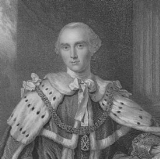
John Stuart, 3rd Earl of Bute
Overview
Order of the Garter
The Most Noble Order of the Garter, founded in 1348, is the highest order of chivalry, or knighthood, existing in England. The order is dedicated to the image and arms of St...
, PC (25 May 1713 – 10 March 1792), styled Lord Mount Stuart before 1723, was a Scottish
Scotland
Scotland is a country that is part of the United Kingdom. Occupying the northern third of the island of Great Britain, it shares a border with England to the south and is bounded by the North Sea to the east, the Atlantic Ocean to the north and west, and the North Channel and Irish Sea to the...
nobleman
Nobility
Nobility is a social class which possesses more acknowledged privileges or eminence than members of most other classes in a society, membership therein typically being hereditary. The privileges associated with nobility may constitute substantial advantages over or relative to non-nobles, or may be...
who served as Prime Minister of Great Britain
Prime Minister of the United Kingdom
The Prime Minister of the United Kingdom of Great Britain and Northern Ireland is the Head of Her Majesty's Government in the United Kingdom. The Prime Minister and Cabinet are collectively accountable for their policies and actions to the Sovereign, to Parliament, to their political party and...
(1762–1763) under George III, and was arguably the last important favourite
Favourite
A favourite , or favorite , was the intimate companion of a ruler or other important person. In medieval and Early Modern Europe, among other times and places, the term is used of individuals delegated significant political power by a ruler...
in British politics. He was the first Prime Minister from Scotland following the Acts of Union
Acts of Union 1707
The Acts of Union were two Parliamentary Acts - the Union with Scotland Act passed in 1706 by the Parliament of England, and the Union with England Act passed in 1707 by the Parliament of Scotland - which put into effect the terms of the Treaty of Union that had been agreed on 22 July 1706,...
in 1707.
A close relative of the Clan Campbell
Clan Campbell
Clan Campbell is a Highland Scottish clan. Historically one of the largest, most powerful and most successful of the Highland clans, their lands were in Argyll and the chief of the clan became the Earl and later Duke of Argyll.-Origins:...
(his mother was a daughter of the 1st Duke of Argyll
Archibald Campbell, 1st Duke of Argyll
Archibald Campbell, 1st Duke of Argyll, 10th Earl of Argyll was a Scottish peer.-Biography:The eldest son of Archibald Campbell, 9th Earl of Argyll and Mary Stuart, daughter of James Stuart, 4th Earl of Moray, Campbell sought to recover his father's estates...
), Bute succeeded to the Earldom of Bute
Marquess of Bute
Marquess of the County of Bute, shortened in general usage to Marquess of Bute, is a title in the Peerage of Great Britain. It was created in 1796 for John Stuart, 4th Earl of Bute.-Family history:...
(named after the Isle of Bute
Isle of Bute
Bute is an island in the Firth of Clyde in Scotland. Formerly part of the county of Buteshire, it now constitutes part of the council area of Argyll and Bute. Its resident population was 7,228 in April 2001.-Geography:...
) upon the death of his father, James Stuart, 2nd Earl of Bute
James Stuart, 2nd Earl of Bute
James Stuart, 2nd Earl of Bute was the son of James Stuart, 1st Earl of Bute and Agnes Mackenzie.-Family:In February 1711, he married Lady Anne Campbell and had eight children:*John Stuart, 3rd Earl of Bute *James Stuart-Mackenzie James Stuart, 2nd Earl of Bute (before 1696 – January 28, 1723)...
, in 1723.
Discussions

